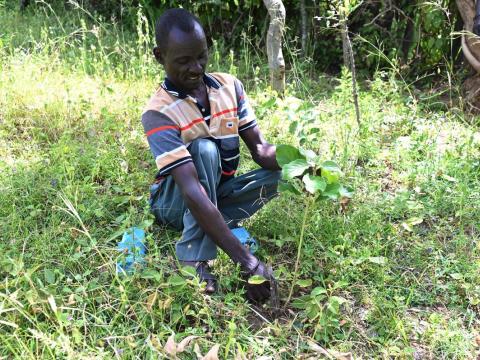Reviving Hope in Mozambique through Regreening

By Mclarence Mandaza, Technical Lead – Environment Sustainability & Climate Action, World Vision Southern Africa
“This land used to be a xitsetso,” the community leader explained, using the Changana word for “dense forest,” as we stood under the scorching sun in Covela village, Gaza Province, Mozambique.
We were here to conduct a community simulation as part of World Vision's Regreening Communities training. The goal: equip field staff with field practical experience to help communities restore, protect, and conserve their landscapes.
Villagers shared how their once-thriving forest disappeared. Years of walking long distances to the Limpopo River for water exposing women and children to risk led many to settle near the forest. It brought temporary relief but accelerated deforestation.Communities slowly started creeping into the “xitsetso” dense forest near the river to easily access water. Trees were cut down, land was laid bare, and the consequences became severe. Topsoil washed away during rains, erosion scarred the land, and crop yields plummeted.
“Due to the intense heat, our fields no longer yield anything. The children go hungry, many drop out of school and we have nothing to give them,” shared Luís Simango, one of the community members.
Walking through the village, I was struck yet again by the harsh realities of climate change. Seeing a mother cradling her newborn, I couldn’t help but wonder what future she would describe to her child.
As our visit continued, we heard how degraded soils and failing crops were worsening child malnutrition and school dropouts. With few income options, families turned to charcoal production cutting down trees for quick cash, especially to meet demand in Maputo, 250 km away.
“We have very few options. We once relied on farming to feed ourselves, but with the changing climate, the land no longer produces enough. And with no employment opportunities, we’re left with no choice but to cut down trees to make charcoal so we can feed our families.” said Ismael Cumba.
Eventually, our discussion shifted from problems to solutions. At first, the community looked outward calling for stronger laws, more fencing, and government action.
But as we reflected together, on the root causes of this massive land degradation and the future they want to see for their children, conversation turned into what communities can actually do by themselves. They began to unearth local, indigenous solutions. One promising idea was live fencing planting indigenous trees around fields and homes to serve as natural barriers.
We introduced World Vision’s regreening communities model, including Farmer Managed Natural Regeneration (FMNR) as a simple, cost-effective method of encouraging natural tree growth by pruning unproductive branches while protecting healthy shoots. This technique allows communities to sustainably harvest branches for firewood or charcoal without cutting down entire trees. It’s practical, scalable, and community-driven.
When we demonstrated FMNR in action, a shift occurred. The mood lightened. Faces that once seemed hopeless lit up with renewed energy and ideas. They spoke of combining trees with crops agroforestry and restoring traditional practices that once preserved the forest.
As we drove away from the village, the sight of charcoal sacks awaiting transportation,charcoal-laden trucks heading toward Maputo brought fresh urgency. Each truck represented thousands of lost trees and a productive forest denied for the children.
According to local producers, one 50–60 kg bag of charcoal requires roughly 0.25 cubic metres of wood, the equivalent of a full mature tree. A truckload of 100 bags translates to 25 cubic metres of wood. Considering ten trucks of charcoal per day, that amounts to 250 m³, or approximately 1,000 trees down everyday. This translates to 7,500 m³ chopped down per month, meaning around 30,000 trees. In a year, 91,250 m³ ischopped. According to Global Forest Watch, Mozambique lost 342 000ha of natural forest, equivalent to 126 Mt of CO₂ emissions in 2024.
This is why World Vision is committed to designing sustainable alternatives. We are integrating income-generating activities like beekeeping, agroforestry , fruit trees and non-timber forest products (NTFP) value chains to reduce reliance on charcoal.
We are promoting clean cookstoves and preparing communities to benefit from carbonmarkets through integration with regreening activities. But policy matters too. Delayed environmental strategies are a denial of a future to children. Our restoration target in Southern Africa aims to restore 4,8 million hectares by 2033.
Our commitment is clear: equip communities to lead restoration efforts, and work with governments to shape policies that reverse deforestation. Because one day, the xitsetso of Covela can rise again greener, stronger, and full of life for generations to come.